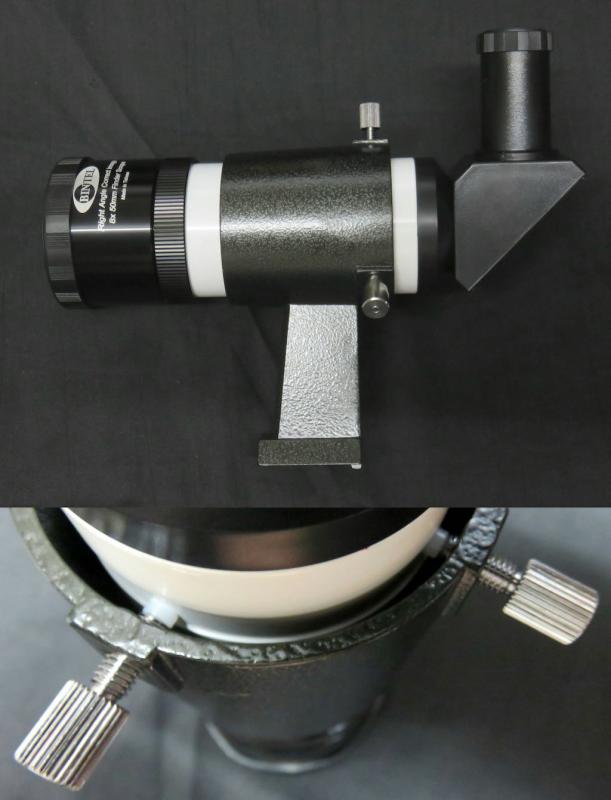2020 July 5
Finder telescopes
Users of all but the smallest wide-field telescopes will have need for some aid in getting their telescope aligned on objects of interest in the sky. It may be a simple sighting device (not much good at night), a red-dot laser unit, or a finder telescope. The red-dot finders work very well but require the target to be visible to the naked eye, otherwise its position must be estimated with respect to naked-eye stars. There are also the perennial issues of flat batteries and corroded connections in the damp night air. Therefore most observers prefer finder telescopes. One major advantage of these is the ability to see faint targets. Another is the ability to reference nearby fields at this same enhanced level.
Optical considerations
A finder telescope is a simple refractor with a cross hair inserted centrally at the focus of the eyepiece. Typically the eyepiece field of view has an apparent diameter of around 50º, so that a 5x finder would have a field of view of 10º, a 7x, 7º, and a 10x, 5º. (For comparison, the apparent diameter of the Moon is around 0.5º). The pupil of a young person’s eyes can dilate to 7mm under dark conditions, but by the time 70 years of age is reached, around 5mm is the limit. To maintain a comfortable bright image in a finder telescope the exit pupil or shaft of light issuing from the eyepiece should reasonably be between 5mm and 7mm. As the exit pupil decreases below 5mm the night time image becomes progressively dimmer, and this makes the crosshairs (unless illuminated) harder to see. Whilst still providing a reasonable image, an exit pupil larger than 7mm will be subject to some loss of light because the eye cannot fully accommodate it. The size of this exit pupil (EP) is determined by dividing the aperture of the finder by the magnification. Common sizes of finders are 5x24mm (4.8mm EP), 6x30mm (5mm EP), and 7x50mm (7.1mm EP). The ubiquitous 50mm finders come in 7, 8, and 9x variants, which all are equally acceptable.
The cheapest common finder is the 5×24, but here I sound a warning. The manufacturers of cheap telescopes sometimes cut corners and replace the two element front lens with a single element. In order to still maintain a reasonable image, they place a plastic aperture stop behind the front lens, reducing its effective size to between 8mm and 12mm so that the result is (say) a 5×10 finder with a very faint image. This trick is easy to detect: just look through the finder telescope from the front to ensure you can see the whole width of the lens is unobstructed.
Finder telescopes
Like a standard astronomical telescope, finders give an inverted image. The view in the finder needs first to be related to the naked eye view, and then to the telescopic view, which in telescopes with eyepiece diagonals will be upright but mirror-reversed.
Mounting and adjustment
Finders are held using finger-tightened screws that bear on the finder tube through mounting rings. There are either two rings with three screws each, or a unit that holds the tube at the front in a rubber O-ring, and at the back either with three screws, or two screws plus a spring-loaded plunger. The sprung arrangement is the most commonly seen today, and has the advantage that you do not need to keep loosening one screw whenever you tighten another. The finder mounting is usually clamped into a shoe with another thumbscrew, the shoe being either screwed to the telescope, or an integral part of the focuser.
If the telescope is mounted equatorially then the finder will at times be under the tube, or in a position very difficult to access. Some Newtonian telescope tubes are rotatable, which can solve this problem, both for the main eyepiece and the finder. Alternatively, some observers have two (or more) finders located on the main telescope tube, in order that at least one will be conveniently positioned at any orientation.
Finders are best adjusted initially in the daytime, by lining the telescope and finder crosshairs up simultaneously with a distant, sharp, fixed object such as an aerial or streetlight. The alignment is refined at night using a bright star or planet, but if the telescope is not driven, this requires some skill in anticipating the drift of the object. Most finders are focused by screwing the objective in or out, then locking it in place with a ring.
Right-angle finders

https://britastro.org/wp-content/uploads/2020/07/6x30-finder.JPG
| The British Astronomical Association supports amateur astronomers around the UK and the rest of the world. Find out more about the BAA or join us. |
